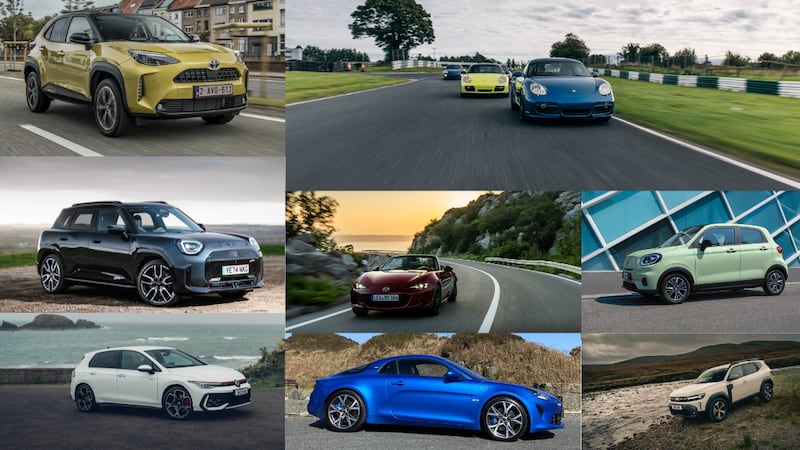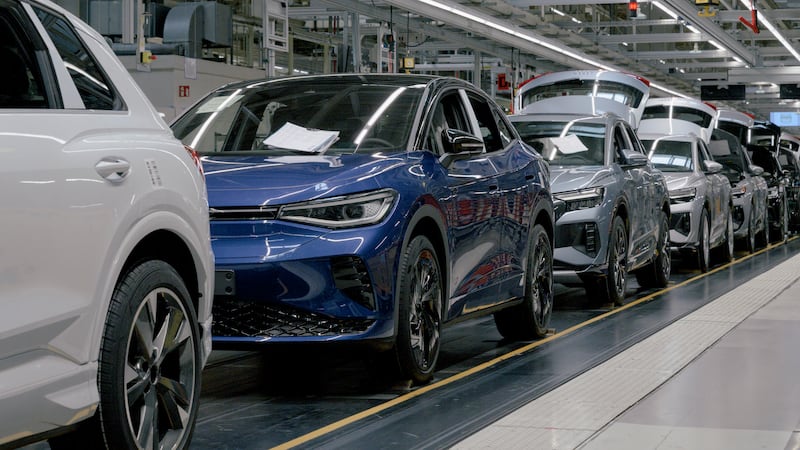It is catastrophically easy to tumble down the ziggurat pyramid of excellence, at least when it comes to the sports saloon segment. The boundaries of the class are constantly shifting - new or at least recent entrants such as the Jaguar XE, VW Arteon, or Alfa Romeo Giulia seeking to upend the status quo - and the three big German brands constantly vying and shuffling for the top spot overall.
Hence why Mercedes-Benz, for this mid-life update of the C-Class saloon, estate, coupe, and cabriolet, rather gone to town on the upgrades. Bad enough that the current Audi A4 is winning many friends and influencing more, but there's an entirely-new BMW 3 Series just over the horizon, so the C needs to keep itself fresh if it's to compete.
So, while the styling may look either tiresomely or reassuringly familiar (delete according to taste, but we think that the C was already an A in the looks department) underneath and inside the alterations have been quite substantial. That starts in the engine bay where, essentially, all of the core powerplants have been changed. Of currently most significance for Irish C-Class buyers is the fact that the mainstay diesel engines switch from the old 2.1-litre engine to the newer 2.0-litre unit, first seen in the E-Class.
Diesel?
Hang on - a diesel-engined saloon is the mainstay of a range, any range, in this world of diesel hatred and SUV adoration? It seems so - according to Mercedes Ireland, C-Class customers still like their traditional four-doors, and they're not, not yet anyway, moving away from diesel. Those thinking that diesel is going away, though, might like (or hate, your pick) to hear that the C-Class' head of powertrain development, Olaf Könning, told The Irish Times that: "In order to reach our climate and emissions targets, a diesel engine is indispensable."
Frankly, one can see why. Parking, for a moment, the furore over emissions cheating and environmental harm, when you drive an engine such as this, you soon realise that it was not merely the shifting of the motor tax bands that drove people into diesel’s arms. It’s the all-round performance and economy that’s so compelling.
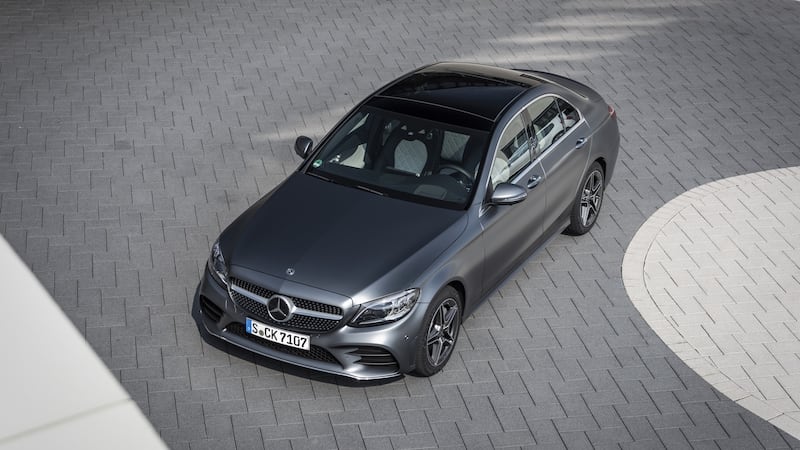
How else would one have an engine that’s equally happy pounding the outside lane of an Autobahn at a rock-steady 220km/h and yet can return close to 60mpg on a gentler run? The 194hp 220d version of the engine does all that with ease, and the only downside is that it can be rather too vocal even under a light throttle. The old 2.1-litre version was annoyingly rattly all the time, so the fact that this engine quietens down when you’re cruising gently is a bonus, but it’s not the refinement revolution we’d been hoping for.
New petrols
There is a touch more revolution if you do fancy a switch to petrol. Mercedes is introducing a new family of four-cylinder turbo petrol engines which have an ‘EQ Boost’ 48-volt mild-hybrid module as standard. Put simply, this consists of a compact lithium-ion battery and a belt-driven starter/generator motor, which can add an extra 14hp to the engine’s performance when you need it. Low down, you can really feel the assistance, as the electric boost definitely helps to fill in while the turbo (a twin-scroll unit) works its way up to speed. Only the slightly tardy action of the nine-speed automatic gearbox spoils the fun, but those trading out of a diesel will find that they still have that pleasant sense of low-down kick when accelerating.
Refinement, though? Hmmm. Not so much, as there’s an annoyingly gravelly edge to the engine’s voice at times that rather spoiles the aural mood. Fuel consumption is in the ‘remains to be seen’ column too - for what it’s worth, we got 24mpg over a short test route, but that did include some high-speed Autobahn work, so it’s not representative of Irish conditions. Figure on 40mpg or thereabouts being a reasonable figure, and Co2 emissions of 136g/km mean €280 a year on motor tax. Prices for the C-Class range are expected to rise when this new model arrives in September, but only marginally.
Familiar
Apart from the new engines, the rest of the C-Class feels very familiar. Some 6,500 components are new, around half the entire car according to Mercedes, but from behind the wheel you’d be hard-pressed to notice. There are new (optional) all-digital instruments, which look good but they’re not integrated with the (also larger) central infotainment screen, so it’s not as dramatic a cabin as you get in the E-Class nor A-Class.
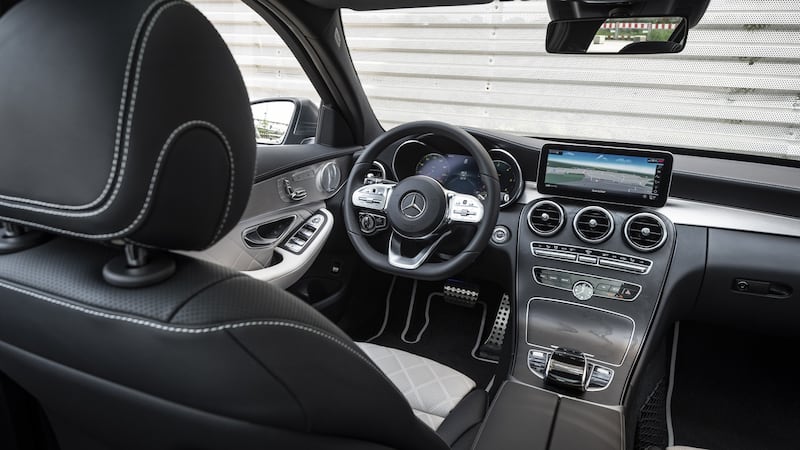
There are new steering wheels, essentially lifted from the S-Class (as is much of the electrical architecture of the car, and many of the higher-end safety systems) and some new trim, but for the most part existing owners won’t be shocked by any major changes to their surroundings. It’s still comfortable, roomy, and aside from the odd cheap-y bit of plastic, very well put together.
Comfort setting
The handling and ride feel much the same too, in spite of revisions to the optional Dynamic Body Control adaptive suspension. Comfort mode still feels like the best setting, with its relaxed ride quality and oily steering feel. That steering weights up in Sport (without transmitting any extra actual road feel) but the ride quality, certainly on the bigger wheel options, becomes just too stiff and fidgety at that point. Better to stick with the smaller wheels which, in 17-inch ‘Aero’ form actually knock a little off the overall Co2 figure.
If it seems hard to square the appeal of the diesel four-door saloon in today’s motoring environment (and with a still-unspecified number of Mercedes diesel cars needing to be recalled for emissions software changes) then perhaps that’s just giving in too easily to the headlines.
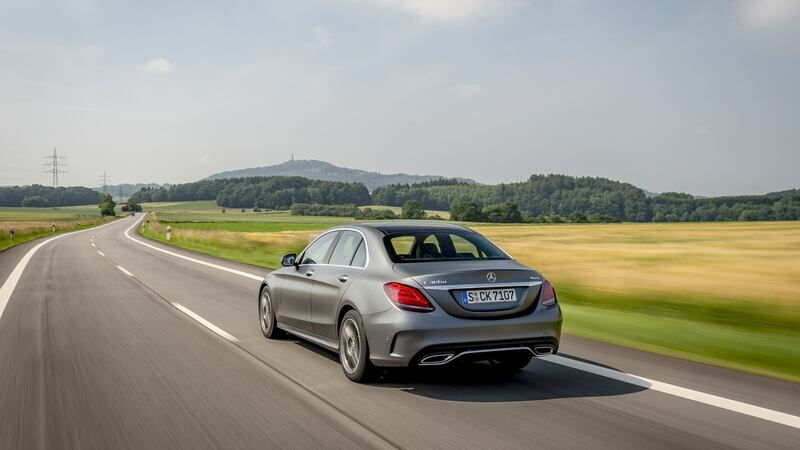
We may (or may not) be a mere dozen years away from the end of sales for cars with exhaust pipes, but until that day dawns, this is still a roundly impressive car, one that reminds you that conventional vehicles can yet be as satisfying (more so, in fact) than a faddish SUV. There’s more to come, too. Next year the C-Class gets a new plugin hybrid diesel engine that could, just could, turn the whole current debate about the evils of diesel on its head. Conventional cars still have some cards to play, it seems.
The lowdown: Mercedes-Benz C-Class C220d Estate
Price: TBA. Power: 194hp. Torque: 400Nm. 0-100kmh: 7.0sec. Top speed: 233kmh. Claimed economy: 60.1mpg (4.7 litres/100km). CO2 emissions: 123g/km. Motor tax: €270. Verdict: Updates keep the C-Class up at the peak of the saloon car pyramid. Our rating: 4/5









